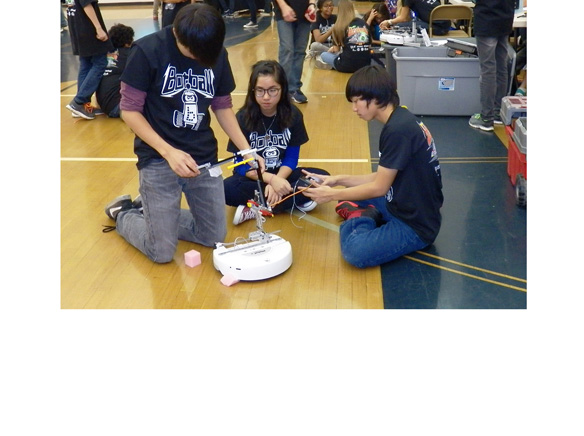What could be more fun than becoming immersed in video gaming? How about designing and building an artificial-intelligence-controlled robot for gaming competition?
What could be more fun than becoming immersed in video gaming? How about designing and building an artificial-intelligence-controlled robot for gaming competition?
On March 21, brought together over 40 middle school and high school competitive teams, vying on game tables in the gymnasium at Santee’s West Hills High School, putting their robotics skills to the test in two-minute match games known as Botball. This was the Greater San Diego Regional Botball Robotics Tournament, and teams from throughout San Diego County were pitted against teams that had traveled from elsewhere in California (Indio, Rancho Mirage and Palm Desert), from Fountain Hills, Arizona, and from Mexico City.
The students ranged in age from 12 to 18. East County teams entered in the tournament hailed from Valhalla High School, and middle schools Carlton Oaks in Santee, Vista La Mesa in Lemon Grove, and PRIDE Academy in Santee.
The object of Botball is to use a pair of student-designed, built and run robots to rack up points by moving game board objects to specific locations on the board. Each team has one small and one large robot. Different tasks are awarded varying point values, based on degree of difficulty. No adults assist the student teams on game day, and the robots must remain in a cordoned-off area called “the pits.” Botball combines electrical engineering, robot building and coding of the computer programs running robot actions in conjunction with information from the robot’s onboard sensors. There are no remote controllers. The robots operate through programmed rules guiding their actions.
Morning sessions were devoted to seeding the teams, based on points scored. Afternoon was for double-elimination rounds to find the ultimate winner.
The tournament was staged under umbrella auspices of the nonprofit KISS Institute for Practical Robotics (KIPR), which describes itself as consisting of “Innovators in STEM Education” referring to science, technology, engineering and mathematics. Other lead sponsoring organizations included the San Diego Science Alliance and the Exploring STEM Careers Initiative.
Steve Goodgame came from Norman, Oklahoma, to oversee this tournament. He serves as executive director for KIPR. He outlined each yearly cycle as beginning in January, with professional development workshops to train teachers in how to lead the student robotics teams. Trained instructors work as needed with experts in electrical engineering to assist the students as they design and build robots and configure the robotics software running the robots’ actions. Regional tournaments are followed by national and international playoffs. The Greater San Diego Regional Botball Tournament is the second largest that KIPR assists with conducting. (A similar contest was being held in Zimbabwe, Africa, on March 21.)
Goodgame noted that these robotics games teach youngsters computer coding, design engineering and 21st century “soft skills.” He cites the facts that around 70 percent of future jobs will rely on computer programming capabilities, that teamwork will be crucial for success and that “a diverse team produces better software design.” He further noted that this is real-life programming. “This is the real deal,” he said.
Each year’s tournaments have a scenario describing the tasks to be accomplished. This year, the game story described the robots as geological surveyors searching for minerals in the New Mexico Mountains, under the guidance of cousins Botguy and Botgal. But Botgal lost contact with Botguy, who was imprisoned in a pod by visiting extra-terrestrials. Four key missions in this background tale are to analyze “minerals” gathered (cubes, poms or ping pong balls), to collect “gold ore” (gold poms) and gold nuggets (ping pong balls), to rescue (bringing back Botgal, Botguy in his ET pod or any UFOs encountered), and to move (taking “gold nuggets” and “cubed minerals” from resting places).
A central element of design is game strategy. Once the robot sensors have identified a game object, should the robot sweep the objects around the board or pick the objects up? Should the robot instead focus more activities on blocking opposition robots from moving objects? Should the robot feature an arm, a claw or a scoop?
Three East County teachers, each a first-time participant in leading after-school robotics lessons, discussed their teams. Pamela Mitchell teaches seventh and eighth-graders at Carlton Oaks. She majored in English. After initial exposure to robotics, Mitchell said, “This is so much fun. I loved it. Coding is easy. I’m a better builder than coder, but I can do both.”
Her students went through eight or 10 design tests. “They decided to be simple, and just score points, because this is their first year,” she said.
She said she loved listening to the student conversations, as they became better friends and appreciated each other’s differences. Her team members had bonded so closely, they planned to have dinner together that night, after the tournament.
Linda Ha’s students are sixth through eighth-graders at Vista La Mesa, which teaches kindergarten through eighth grade children. This is her first year at Vista La Mesa, and her interests lie in teaching automation and robotics. She said that the Botball project is “very exciting” in driving up student awareness of science and technology.
Cindi Schulze teaches seventh and eighth-graders at Santee’s PRIDE Academy, also a K-8 school. (PRIDE stands for Purposeful, Rigorous, Innovative, and Dynamic Education). She found the coding a challenge because of the rigor required. She mentioned as standout observations that the children learned research and problem-solving skills and were more aware of engineering as an interesting field of further study. She spoke enthusiastically about aligned social and interpersonal skills her robotics team members acquired through collaboration. Her seven-member team was split between three girls and four boys. They were forced to rely on each other and to communicate well.
“I saw a couple of kids who came out of their shells after being shy. They all took pride in their work, and this is a huge commitment of after-school time on their part. But this is so much fun, this is teaching kids who want to learn, who want to be here,” she said.
Schulze and Mitchell said that their graduating classes of eighth-graders are planning to collaborate on starting a new robotics club when they reach West Hills High School.
These East County teachers and KIPR’s Goodgame pointed out that despite the high level of student interest in such robotics work and the practicality of early training in the field for next-generation workforce development, a remaining problem is the money to pay for the programs. The current year of participation in this Botball tournament was made possible by a three-year grant of $1.2 million from the National Science Foundation to examine how participation in this robotics competition as an after-school activity influences teachers and their students. The money funded 14 teams and paid for training 30 teachers this year.
David Massey has been project director for all three of these grant-funded years. A middle school science teacher in Santee for 34 years, he had started coaching Botball in 2000 as a volunteer. According to Massey, the NSF dollars doubled the number of students who were able to participate. “This scaled up from what I was doing as a volunteer,” he said.
He said in particular how the program allowed children from low-income county areas access to robotics.
Nancy Taylor, a co-founder of the San Diego Science Alliance, is principal investigator for the NSF grant, and she is about to publish findings from her research. A key question she asked was about how teaching robotics lessons after school affected teachers’ in-class instructional practices. She discovered that the teachers became enthusiastic advocates and would indeed add robotics into the curriculum, but for the costs involved in participation. Equipment, computer coding software and tournament fees added up to about $2,500 per team for this project.
Students who signed up for Botball increased awareness of science and technology as possible career paths. Taylor learned that these competitors reached important realizations about problem solving and critical thinking skills.
“The kids report they never know teamwork could be so fun, or so hard,” Taylor said.
Their take-away lessons included experience with trial and error, collaboration and shared responsibilities. This particular educational exercise is different from most other classroom studies as well, in that building a robot has “more than one right answer,” said Taylor.
“We feel a responsibility to let members of the community know that we will need help to continue these programs, as the NSF grant is ending this year,” said Taylor
East County teachers concurred as well, that volunteers and sponsors are needed.
The overall winner was one team from the Palm Desert High School Aztecs. From East County, Cindi Schulze’s PRIDE Academy team went furthest, into the third double-elimination bracket.
Find the final results of the Botball Tournament at http://www.botball.org/sca/2015/results.














